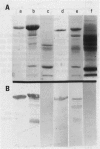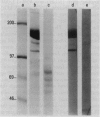Abstract
Vitellogenin (VTG), the serum phospholipoglycoprotein precursor to egg yolk, is potentially an ideal biomarker for environmental estrogens. This study was undertaken to develop antibodies against conserved regions on the VTG molecule that could form the basis for establishing bioassays to detect estrogen exposure in any oviparous vertebrate. We developed monoclonal antibodies (mAbs) generated against purified rainbow trout (Oncorhynchus mykiss) VTG and selected for the property of specifically recognizing VTG purified from two phylogenetically distant vertebrates, trout and striped bass (Morone saxatilis). Results of enzyme-linked immunosorbent assay and Western blotting indicated that these mAbs specifically recognize purified VTG and VTG or other estrogen-inducible proteins in plasma or serum from representative species of four vertebrate classes (fish, amphibians, reptiles, and birds). All of the mAbs generated were IgM class. A polyclonal antiserum was raised against a synthetic consensus peptide representing the conserved N-terminal amino acid sequence of VTG. The results of Western blotting indicate that this antiserum specifically recognizes VTG in plasma or serum from teleost fish of diverse families. It was used to detect VTG in Western blots of serum from brown bullhead (Ameiurus nebulosus) with cancer (hepatocellular and cholangio-carcinoma) collected from a contaminated industrial site outside of their normal vitellogenic season. Our results indicate that it is feasible to generate antibodies capable of recognizing VTG without regard to species and that development of a universal VTG assay is an achievable goal.
Full text
PDF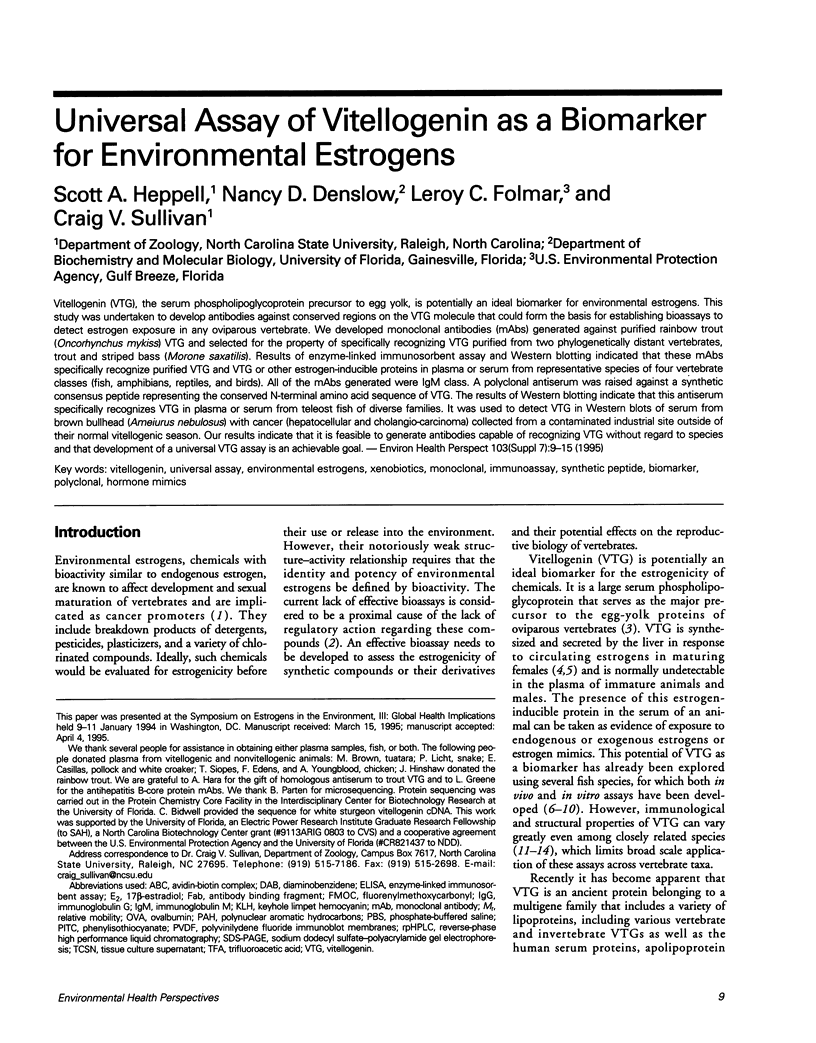
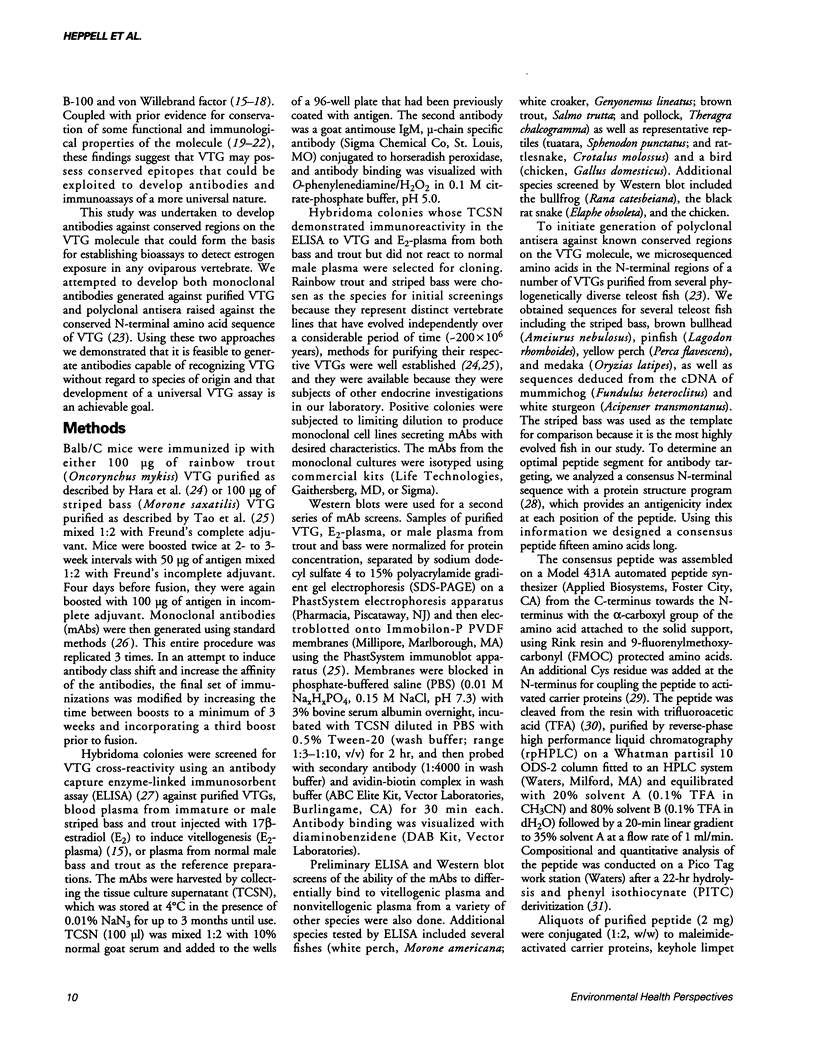

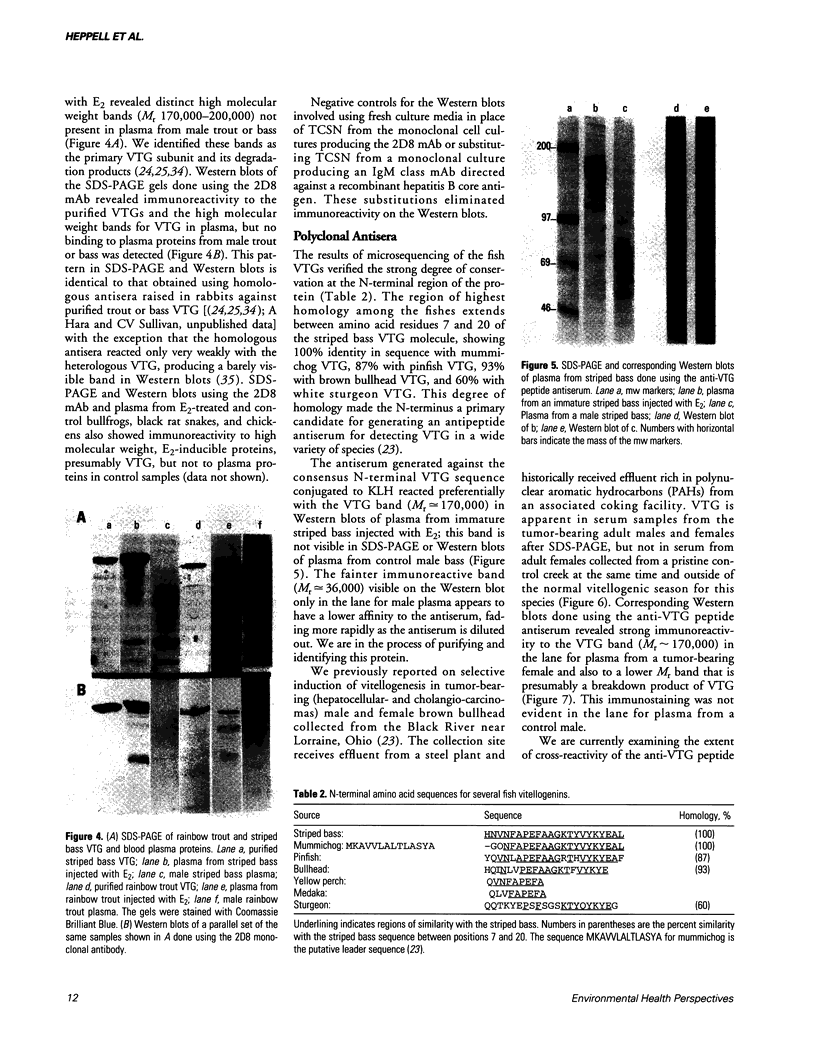
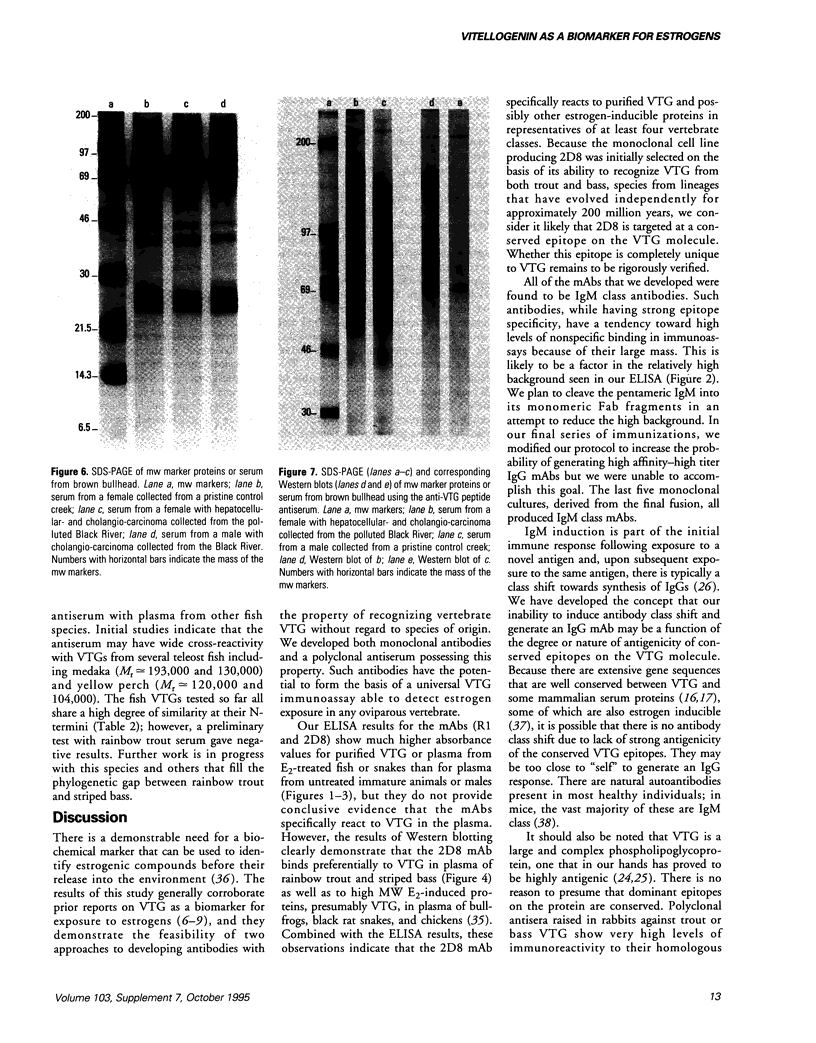
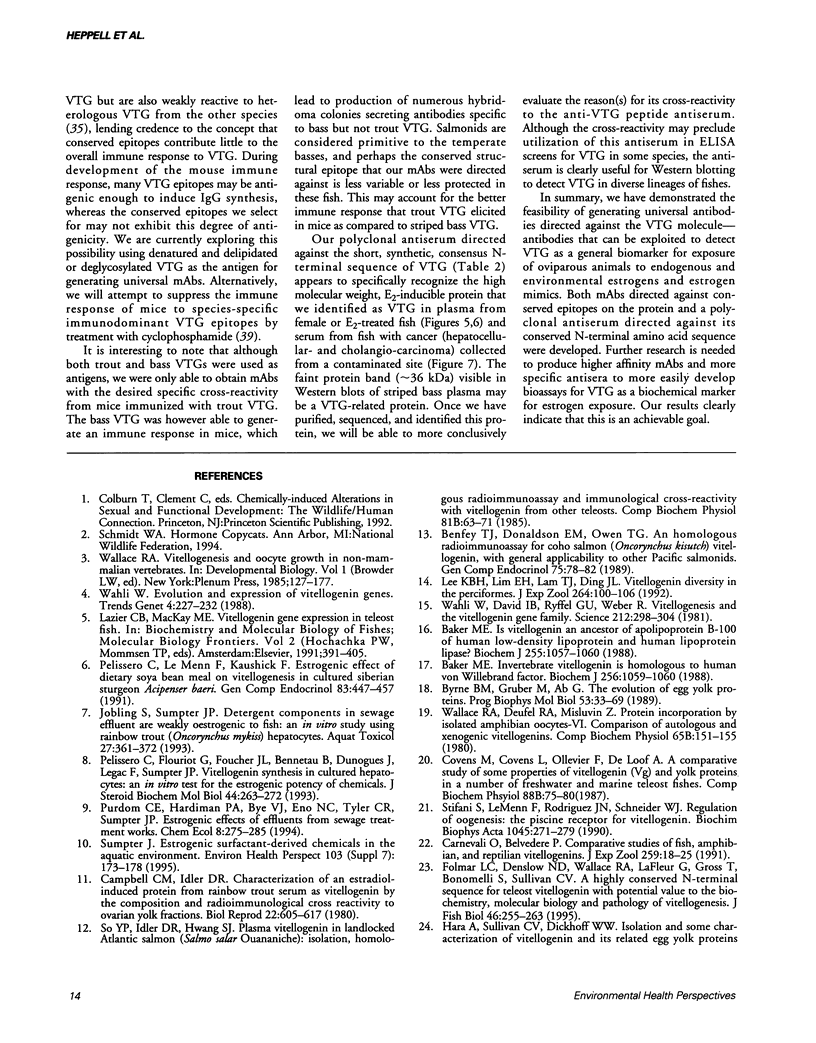
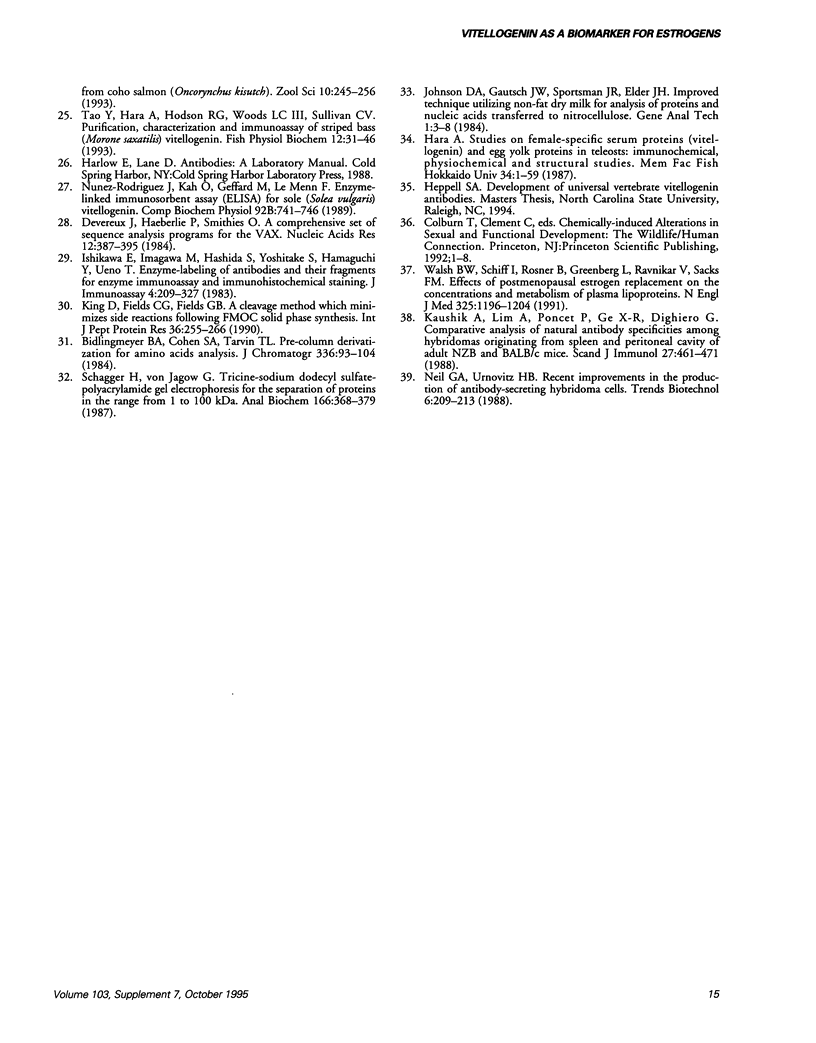
Images in this article
Selected References
These references are in PubMed. This may not be the complete list of references from this article.
- Baker M. E. Invertebrate vitellogenin is homologous to human von Willebrand factor. Biochem J. 1988 Dec 15;256(3):1059–1061. doi: 10.1042/bj2561059. [DOI] [PMC free article] [PubMed] [Google Scholar]
- Baker M. E. Is vitellogenin an ancestor of apolipoprotein B-100 of human low-density lipoprotein and human lipoprotein lipase? Biochem J. 1988 Nov 1;255(3):1057–1060. doi: 10.1042/bj2551057. [DOI] [PMC free article] [PubMed] [Google Scholar]
- Benfey T. J., Donaldson E. M., Owen T. G. An homologous radioimmunoassay for coho salmon (Oncorhynchus kisutch) vitellogenin, with general applicability to other Pacific salmonids. Gen Comp Endocrinol. 1989 Jul;75(1):78–82. doi: 10.1016/0016-6480(89)90010-5. [DOI] [PubMed] [Google Scholar]
- Bidlingmeyer B. A., Cohen S. A., Tarvin T. L. Rapid analysis of amino acids using pre-column derivatization. J Chromatogr. 1984 Dec 7;336(1):93–104. doi: 10.1016/s0378-4347(00)85133-6. [DOI] [PubMed] [Google Scholar]
- Byrne B. M., Gruber M., Ab G. The evolution of egg yolk proteins. Prog Biophys Mol Biol. 1989;53(1):33–69. doi: 10.1016/0079-6107(89)90005-9. [DOI] [PubMed] [Google Scholar]
- Campbell C. M., Idler D. R. Characterization of an estradiol-induced protein from rainbow trout serum as vitellogenin by the composition and radioimmunological cross reactivity to ovarian yolk fractions. Biol Reprod. 1980 Apr;22(3):605–617. doi: 10.1093/biolreprod/22.3.605. [DOI] [PubMed] [Google Scholar]
- Devereux J., Haeberli P., Smithies O. A comprehensive set of sequence analysis programs for the VAX. Nucleic Acids Res. 1984 Jan 11;12(1 Pt 1):387–395. doi: 10.1093/nar/12.1part1.387. [DOI] [PMC free article] [PubMed] [Google Scholar]
- Ishikawa E., Imagawa M., Hashida S., Yoshitake S., Hamaguchi Y., Ueno T. Enzyme-labeling of antibodies and their fragments for enzyme immunoassay and immunohistochemical staining. J Immunoassay. 1983;4(3):209–327. doi: 10.1080/15321818308057011. [DOI] [PubMed] [Google Scholar]
- Kaushik A., Lim A., Poncet P., Ge X. R., Dighiero G. Comparative analysis of natural antibody specificities among hybridomas originating from spleen and peritoneal cavity of adult NZB and BALB/c mice. Scand J Immunol. 1988 Apr;27(4):461–471. doi: 10.1111/j.1365-3083.1988.tb02372.x. [DOI] [PubMed] [Google Scholar]
- King D. S., Fields C. G., Fields G. B. A cleavage method which minimizes side reactions following Fmoc solid phase peptide synthesis. Int J Pept Protein Res. 1990 Sep;36(3):255–266. doi: 10.1111/j.1399-3011.1990.tb00976.x. [DOI] [PubMed] [Google Scholar]
- Pelissero C., Flouriot G., Foucher J. L., Bennetau B., Dunoguès J., Le Gac F., Sumpter J. P. Vitellogenin synthesis in cultured hepatocytes; an in vitro test for the estrogenic potency of chemicals. J Steroid Biochem Mol Biol. 1993 Mar;44(3):263–272. doi: 10.1016/0960-0760(93)90086-c. [DOI] [PubMed] [Google Scholar]
- Pelissero C., Le Menn F., Kaushick S. Estrogenic effect of dietary soya bean meal on vitellogenesis in cultured Siberian sturgeon Acipenser baeri. Gen Comp Endocrinol. 1991 Sep;83(3):447–457. doi: 10.1016/0016-6480(91)90151-u. [DOI] [PubMed] [Google Scholar]
- Schägger H., von Jagow G. Tricine-sodium dodecyl sulfate-polyacrylamide gel electrophoresis for the separation of proteins in the range from 1 to 100 kDa. Anal Biochem. 1987 Nov 1;166(2):368–379. doi: 10.1016/0003-2697(87)90587-2. [DOI] [PubMed] [Google Scholar]
- Stifani S., Le Menn F., Rodriguez J. N., Schneider W. J. Regulation of oogenesis: the piscine receptor for vitellogenin. Biochim Biophys Acta. 1990 Aug 6;1045(3):271–279. doi: 10.1016/0005-2760(90)90130-p. [DOI] [PubMed] [Google Scholar]
- Sumpter J. P., Jobling S. Vitellogenesis as a biomarker for estrogenic contamination of the aquatic environment. Environ Health Perspect. 1995 Oct;103 (Suppl 7):173–178. doi: 10.1289/ehp.95103s7173. [DOI] [PMC free article] [PubMed] [Google Scholar]
- Wahli W., Dawid I. B., Ryffel G. U., Weber R. Vitellogenesis and the vitellogenin gene family. Science. 1981 Apr 17;212(4492):298–304. doi: 10.1126/science.7209528. [DOI] [PubMed] [Google Scholar]
- Wahli W. Evolution and expression of vitellogenin genes. Trends Genet. 1988 Aug;4(8):227–232. doi: 10.1016/0168-9525(88)90155-2. [DOI] [PubMed] [Google Scholar]
- Wallace R. A. Vitellogenesis and oocyte growth in nonmammalian vertebrates. Dev Biol (N Y 1985) 1985;1:127–177. doi: 10.1007/978-1-4615-6814-8_3. [DOI] [PubMed] [Google Scholar]
- Walsh B. W., Schiff I., Rosner B., Greenberg L., Ravnikar V., Sacks F. M. Effects of postmenopausal estrogen replacement on the concentrations and metabolism of plasma lipoproteins. N Engl J Med. 1991 Oct 24;325(17):1196–1204. doi: 10.1056/NEJM199110243251702. [DOI] [PubMed] [Google Scholar]



